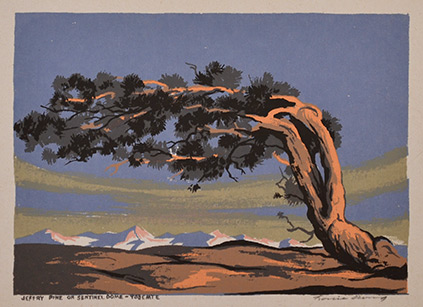Today's Printmaker You Should Know is best remembered for his work in serigraphy, also known as silkscreen: Louie Ewing (1908-1983).
Ewing was originally from Idaho, and moved to California to study art. He first made his way to New Mexico in 1935, when he and one of his professors, Stanley Breisener, moved to Santa Fe to teach at the Eidolon Art School. That venture was short-lived, the school closed after one year, but Ewing stayed in the area.
Ewing became acquainted with silkscreen through the WPA, when the regional head of the program, Russell Vernon Hunter, suggested that he explore the medium, as it might prove an easier and more cost-effective way of documenting artifacts than woodcuts and other tedious mediums (Hunter, you may be interested to know, would later become director of the Roswell Museum; Hunter Gallery is named for him). So Ewing went off to the silkscreen workshop in Santa Fe, and soon enough was creating prints.
Ewing's especially remembered for his silkscreens of Navajo blankets, which constituted a portfolio of blanket designs spanning the years 1840-1910. This project was the brainchild of Russell Vernon Hunter and Kenneth Chapman of the Laboratory of Anthropology of Santa Fe. Chapman picked which designs he wanted to have represented, and Ewing created the silkscreens. Being an educational undertaking, the portfolio was circulated among universities, museums, libraries, and other educational institutions. Here are a few examples:
He also produced silkscreens of other artifacts, as well as landscapes:
Ewing was not the first person to take up silkscreen seriously, but he was one of the first to do so in the Southwest, so he's an important figure in the New Mexico art scene.
************
Want to learn more? Of course! Here's some fodder for you:
http://www.annexgalleries.com/artists/biography/2786/Ewing/Louie
http://roswellmuseum.org/exhibitions/past/serigraphs.html
And, as always, check out some of the RMAC's Louie Ewing holdings here.
 |
| Louie Ewing. Image courtesy of http://www.giacobbefritz.com/works/graphicshouse/Ewing/ewing.htm |
Ewing was originally from Idaho, and moved to California to study art. He first made his way to New Mexico in 1935, when he and one of his professors, Stanley Breisener, moved to Santa Fe to teach at the Eidolon Art School. That venture was short-lived, the school closed after one year, but Ewing stayed in the area.
Ewing became acquainted with silkscreen through the WPA, when the regional head of the program, Russell Vernon Hunter, suggested that he explore the medium, as it might prove an easier and more cost-effective way of documenting artifacts than woodcuts and other tedious mediums (Hunter, you may be interested to know, would later become director of the Roswell Museum; Hunter Gallery is named for him). So Ewing went off to the silkscreen workshop in Santa Fe, and soon enough was creating prints.
Ewing's especially remembered for his silkscreens of Navajo blankets, which constituted a portfolio of blanket designs spanning the years 1840-1910. This project was the brainchild of Russell Vernon Hunter and Kenneth Chapman of the Laboratory of Anthropology of Santa Fe. Chapman picked which designs he wanted to have represented, and Ewing created the silkscreens. Being an educational undertaking, the portfolio was circulated among universities, museums, libraries, and other educational institutions. Here are a few examples:
 |
| Image courtesy of: http://www.pinterest.com/pin/70087337920521651/ |
 |
| Image courtesy of: http://www.pinterest.com/jessielgalloway/diy-fashion/ |
 |
| Image courtesy of: http://www.pinterest.com/mdmamabare/weavings/ |
He also produced silkscreens of other artifacts, as well as landscapes:
 |
| San Pasqual, serigraph. Image courtesy of http://art.twostartrading.com/Pages/Gallery1/EwingSanPasqual.html |
 |
| Jeffrey Pine on Sentinel Dome, Yosemite, serigraph. Image courtesy of http://www.photographydealers.com/exhibitions/santa-fe-legacy/ |
Ewing was not the first person to take up silkscreen seriously, but he was one of the first to do so in the Southwest, so he's an important figure in the New Mexico art scene.
************
Want to learn more? Of course! Here's some fodder for you:
http://www.annexgalleries.com/artists/biography/2786/Ewing/Louie
http://roswellmuseum.org/exhibitions/past/serigraphs.html
And, as always, check out some of the RMAC's Louie Ewing holdings here.
Comments
Post a Comment
Questions? Comments? Speak your mind here.